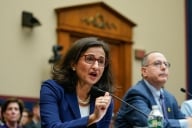You have /5 articles left.
Sign up for a free account or log in.
American colleges and universities were largely spared from the initial outbreaks of the COVID-19 virus due to their rapid transition to online coursework in March as cases in the United States began to climb. When outbreak hotspots emerged in areas with high population density such as nursing homes, meat processing plants and prisons, the decision by administrators across the country for the most part spared higher education institutions from joining that list. Whether that continues to be the case as institutions reopen for fall, however, remains to be seen, given the natural propensities of traditional college-age students.
Although early mitigation efforts seemed to be effective, recent trends suggest that the disease is more rampant and widespread than ever across the country. Each day, the horrifying curve of new COVID-19 infections gets steeper, and the list of locations where outbreaks are occurring gets longer. Yet an overwhelming majority of colleges and universities have announced plans for students to return to their campuses this fall. Those plans entail detailed mitigation strategies such as mandatory masks while on campus, social distancing, reduced classroom density, frequent disinfecting of common areas and takeout meals. But little is known about how colleges and universities will enforce those policies for activities that take place in off-campus settings.
On paper, it appears as if institutions are as prepared as possible for the coming months, yet fears and uncertainty are pervasive behind closed doors. To appeal to the basic needs of college-aged students, administrators have conveyed that the semester will be as close to normal as possible, with some institutions even planning to resume non-essential activities such as fraternity and sorority rush events. Yet faculty and staff members across the country have expressed skepticism regarding the reopening of campuses, some going as far as calling such plans "delusional."
And the fact is that expecting millions of adolescents and young adults to abide by such restrictive measures for months is highly unrealistic. Like most human beings, college students are wired for social connection. They are in the developmental stage of emerging adulthood -- the period between adolescence and adulthood. In a pre-pandemic world, college campuses offered the perfect setting for emerging adults to explore the world both independently and together with their peers. With COVID-19 in our midst, that environment can also be a petri dish like those of senior living facilities, but on a much larger scale.
Colleges that plan to reopen have thus far focused mainly on protocols aimed at reducing the spread of COVID-19 on their campuses. However, they have largely ignored research on adolescent behavior that can inform whether these protocols are adhered to. Developmentally, adolescents and young adults are particularly prone to making mistakes. Research suggests that they often make decisions based on emotions -- known as hot cognitions -- which are associated with increased risky behaviors. Although the typical mistakes resulting from hot cognitions often lead to personal growth, failure to comply with the multitude of restrictions in place during the pandemic could, at best, result in punitive measures against students and, at worst, contribute to the further spread of COVID-19. Additionally, students are far more likely to make irrational decisions in social settings where there is less supervision -- such as bars and parties -- compared to when they are attending classes.
For many current and former college students, risky behaviors are both normalized and celebrated. That's because college students are susceptible to the invincibility fable: a pattern of thought that characterizes adolescents' and young adults' perceptions of invulnerability to the potential consequences of risky behaviors. Much of the media coverage has portrayed younger individuals as being less susceptible to contracting the illness and to experiencing serious consequences if they were to become infected, which has only strengthened the sense of invulnerability among this population. Expecting college students to make rational decisions in the today's climate is akin to asking a child not to cry for its mother -- although it is technically possible, it is highly unlikely because it inherently conflicts with the normal human development process.
A Major Disconnect
As more colleges release their reopening plans, there is clearly a major disconnect between the cognitive frame of the people developing these plans and those who will bear the burden of abiding by such policies. Indeed, even some administrators have expressed uncertainty about whether their plans will work, yet the exaggerated optimism that is expressed in announcements to students conveys a sense of confidence and security for parents and students who are anxiously awaiting the start of courses. As someone who works at a university, I can personally testify to the challenges of abiding by these policies. It is uncomfortable and awkward to wear a mask for any length of time, yet administrators are expecting students to take part in three-hour, in-person classes, with some of these classes scheduled back-to-back -- meaning that students may have to wear masks for up to nine hours per day.
We already have frightening evidence of the thorny issues that will emerge when many students are back on campuses. The first groups of student-athletes who started to return to campuses for "voluntary" conditioning workouts last month have allowed colleges to undergo a trial run with their policies. One official described student-athletes as the guinea pigs for the nationwide experiment that will take place this fall. Reports of numerous cases of COVID-19 among student-athletes at multiple universities throughout the nation have highlighted the myriad challenges that institutions will face this fall -- and on a much broader scale. Those challenges include testing regularly, contact tracing, and enforcement of procedures such as social distancing and wearing masks, which are not 100 percent effective even if students abide by them.
The return of athletes to campuses has highlighted how even the most diligent of individuals can slip up when it comes to following protocols. Student-athletes, many of whom have been without meaningful social interaction since March, can be forgiven for wanting to embrace and spend time with teammates outside of their workouts. Several outbreaks among student athletes have been traced back to social interactions, including athletes playing video games together and going out to bars in the evening. One year ago, such behaviors would have been expected and accepted. This summer and fall they could potentially contribute to a widespread outbreak of a deadly virus on the campus and in the community. To place this much responsibility on kids who are wired to socialize is both immoral and unrealistic.
No one would dispute that the safest plan for colleges and universities would be to administer fall classes online. However, the financial implications for many colleges and universities in this scenario would be crippling. Additionally, students themselves are anxious to return to campus and experience the hands-on teaching model they expected as part of their college experience.
College administrators are in a precarious position, having to balance the survival of their institutions and the achievement of their educational mission with the health and safety of students, faculty and staff. But if administrators continue to emphasize mitigation policies without acknowledging the empirically supported barriers to compliance among adolescents and young adults, the question will probably be when, not if, they'll face major outbreaks of the coronavirus on their campuses.








